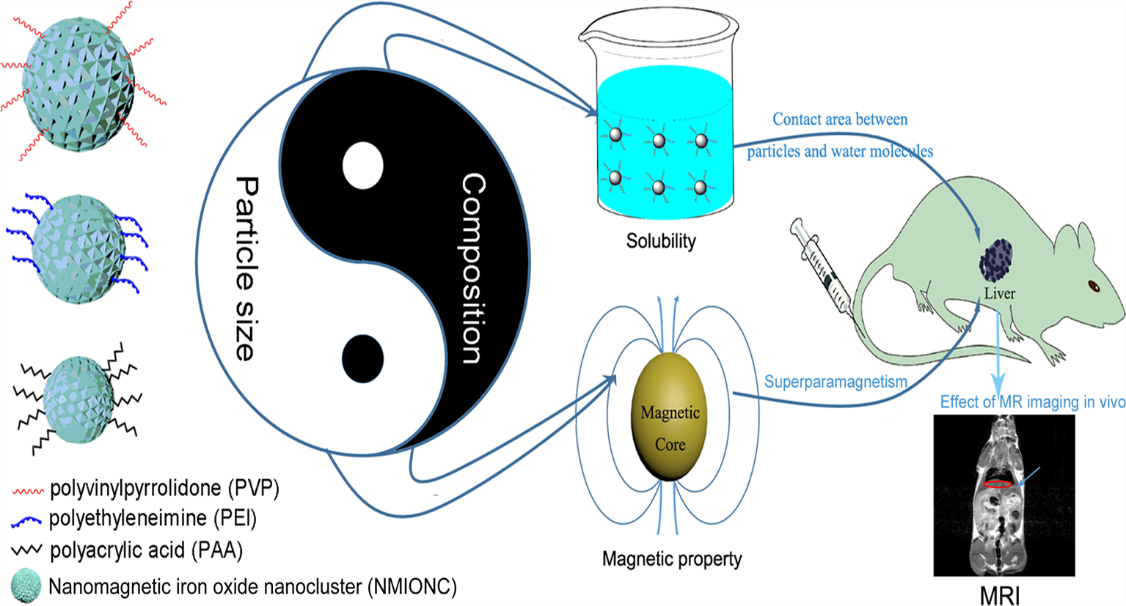Recently, collaborating with researchers from High Magnetic Field Laboratory of the Chinese Academy of Sciences, Professor WU Zhengyan’s team in Institute of Technical Biology and Agriculture Engineering, Hefei Institutes of Physical Science, investigated the effects of size and composition of magnetic iron oxide nanocluster on the variations of magnetism and magnetic resonance contrast ability.
This work would be a great help to fabricate high performance T2-weight contrast agent and magnetic relaxation switch.
Currently, nanomagnetic Iron Oxide (NMIO) has been widely utilized as magnetic resonance contrast agent (MRCA). In addition, some studies found that the monodispersed NMIO nanocrystals exhibited higher T2 relaxation time and lower relaxation rate in comparison with the aggregated NMIO nanocrystals.
Therefore, NMIO nanocrystals could often act as a magnetic relaxation switch (MRS) and be used to detect molecular interactions.
However, there is few report on NMIO nanocluster (NMIONC) as MRS and MRCA because the factors that affect T2 relaxation signal of NMIONC remain unclear.
Therefore, it is necessary to make contrast behavior clear via studying physical parameters of NMIONC, and this could help to design Fe-based CA and MRS with high quality.
In WU’s research, three types of NMIONC were used to explore the effects of size and compositions on the variations of magnetism and MR contrast ability.
It was found that the transverse relaxation rate (r2) of NMIONC depend on the contact area between particles and water molecules. The smaller size and higher solubility could carry out higher contact area between NMIONC and water molecules.
Therefore, the monodispersed NMIONC show a better T2 contrast ability in comparison with the aggregated NMIONC.
Moreover, for NMIONC with the same composition, the magnetism and contrast ability gradually increased while the particle size decreasing. In vivo, NMIONC that possessed the best solubility and the smallest size show the most effective MR contrast effect for the liver region of mice,making the size and composition of NMIONC play important roles in enhancing contrast behavior.
This study provides a new idea to develop high-performance T2 contrast agents (CAs) by modulating the size and composition of particles.
This research was supported by the National Natural Science Foundation of China (No. 21407151), the Youth Innovation Promotion Association of Chinese Academy of Sciences (No. 2015385), the Key Program of Chinese Academy of Sciences (No. KSZD-EW-Z-022-05), the Science and Technology Service Programs of Chinese Academy of Sciences (Nos. KFJ-STS-ZDTP-002 and KFJ-SW-STS-143), and the Science and Technology Major Project of Anhui Province (No. 17030701051). (十日内)
Link to the paper: Fabricating High Performance T2-Weighted Contrast Agent via Adjusting Composition and Size of Nanomagnetic Iron Oxide

Schematic illustration of the factors enhancing T2-weighted contrast ability. (Image by XIAO Jianmin)
Contact:
ZHOU Shu
Hefei Institutes of Physical Science (http://english.hf.cas.cn/)
Email: zhous@hfcas.ac.cn
 Tel: +86-551-65591206
Tel: +86-551-65591206
 Fax: +86-551-65591270
Fax: +86-551-65591270
 Emai: zhous@hfcas.ac.cn
Emai: zhous@hfcas.ac.cn
 350 Shushanhu Road
350 Shushanhu Road